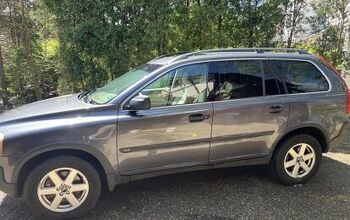Global Debut of Subaru Solterra Takes Place Ahead of American Reveal

While this year’s L.A. Auto Show will be the location in which Subaru shows its new all-electric Solterra on this side on the pond, the new EV – developed in conjunction with Toyota – popped up in an official capacity at a reveal event in Japan. Save for having its steering wheel on the opposite side of the cabin, the machine you see here will be much like the one appearing next week in Los Angeles.
It also looks a lot like its Toyota cousin – much more so than some industry observers expected.
As entrants to the growing all-electric compact crossover market, the Subaru Solterra and Toyota bZ4X are the product of a joint partnership between the two Japanese giants, making the 86/BRZ more than just a one-off collab. While those two machines share a great deal in terms of styling, and some level of body similarities should be expected as a logical part of any joint project like this, it is jarring to see the entire midsection of these two rigs (outsized body cladding and all) wind up as identical units.
Speaking of cladding, is anyone else’s eye offended by the part black/part body-color door for the charging port? It’s not even half-and-half, just an extension of the jumbo wheel arch moldings. Those of you with long memories will recall one of the last Subaru to deal with this styling conundrum, the Baja, chose to simply dip its cladding away from the fuel door on its passenger-side rear fender. This solution breaks my brain.
Anyway, documents for the Japanese-market Solterra reveal both two- and all-wheel-drive variants will be available in that country, with the latter weighing about 200 pounds more than the 4,246 lb rear-driver. Cruising range on a full charge is listed as 330 miles for two-wheel-drive models and approximately 290 miles for those equipped with all-wheel drive. Keep in mind those numbers may change for our market thanks to differences in testing procedures.
Power will check-in at 201 horses (150kW) or 214 ponies (160kW) depending on the number of driven wheels. Again, these are Japanese specs that might change for America. It is odd that the single motor cranks out 150kW while the dual motor option is rated at 80kW each. Given the Subaru propensity for promoting its all-wheel-drive abilities (save for the BRZ, of course), there’s a non-zero chance that only the dual-motor variant will be offered on our shores. Of course, if the company is chasing a particular price point, anything’s possible.
Battery capacity in both models is a tick over 71kWh, with the dual motor’s extra weight explaining its relative lack of range compared to the single motor car. Whether 14 horses is enough to make up for an additional 200 lbs remains to be seen. If you’re wondering about the footprint this car throws down, know it is 8.9 inches longer and 2.4 inches wider than a Crosstrek but only marginally taller.
Subaru has committed to showing a North American spec of the new all-electric Solterra at next week’s auto show in Los Angeles. Tune in for that news when it drops.
[Images: Subaru]

Matthew buys, sells, fixes, & races cars. As a human index of auto & auction knowledge, he is fond of making money and offering loud opinions.
More by Matthew Guy
Latest Car Reviews
Read moreLatest Product Reviews
Read moreRecent Comments
- Master Baiter I thought we wanted high oil prices to reduce consumption, to save the planet from climate change. Make up your minds, Democrats.
- Teddyc73 Oh look dull grey with black wheels. How original.
- Teddyc73 "Matte paint looks good on this car." No it doesn't. It doesn't look good on any car. From the Nissan Versa I rented all the up to this monstrosity. This paint trend needs to die before out roads are awash with grey vehicles with black wheels. Why are people such lemmings lacking in individuality? Come on people, embrace color.
- Flashindapan Will I miss the Malibu, no. Will I miss one less midsize sedan that’s comfortable, reliable and reasonably priced, yes.
- Theflyersfan I used to love the 7-series. One of those aspirational luxury cars. And then I parked right next to one of the new ones just over the weekend. And that love went away. Honestly, if this is what the Chinese market thinks is luxury, let them have it. Because, and I'll be reserved here, this is one butt-ugly, mutha f'n, unholy trainwreck of a design. There has to be an excellent car under all of the grotesque and overdone bodywork. What were they thinking? Luxury is a feeling. It's the soft leather seats. It's the solid door thunk. It's groundbreaking engineering (that hopefully holds up.) It's a presence that oozes "I have arrived," not screaming "LOOK AT ME EVERYONE!!!" The latter is the yahoo who just won $1,000,000 off of a scratch-off and blows it on extra chrome and a dozen light bars on a new F150. It isn't six feet of screens, a dozen suspension settings that don't feel right, and no steering feel. It also isn't a design that is going to be so dated looking in five years that no one is going to want to touch it. Didn't BMW learn anything from the Bangle-butt backlash of 2002?



































Comments
Join the conversation
I give up on Subaru producing a good looking car. I give up. They just can’t do it.
"It also looks a lot like its Toyota cousin – much more so than some industry observers expected." If one starts combing through it, there are probably Toyota stamps on some or most of the components.